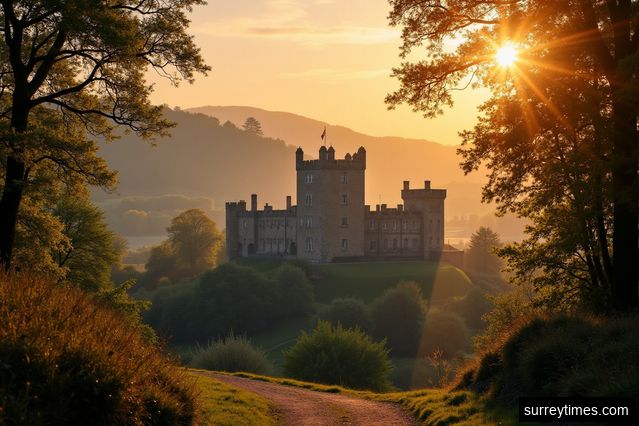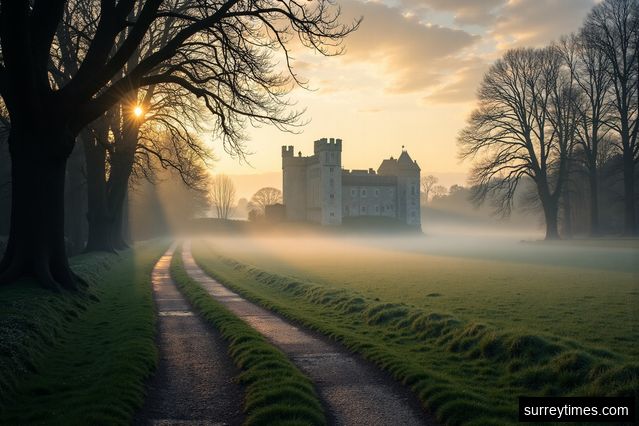Introduction
When one thinks of Surrey, images of picturesque landscapes and quintessentially English countryside might spring to mind. However, nestled within these scenic vistas lies a wealth of history, waiting to be discovered through its landmarks. This journey through time not only uncovers the rich tapestry of Surrey's past but also highlights the significance of preserving these monuments for future generations. From ancient fortresses that whisper tales of yore to stately homes that narrate the evolution of architectural styles, Surrey's landmarks serve as custodians of history, offering insights into the socio-economic and cultural fabric of the times they represent.
This comprehensive exploration will take us through a curated selection of Surrey's most iconic historical landmarks. Each site, a chapter from the past, invites us to step back in time and experience the legacy of the region. Through detailed examination and recounting of their stories, we aim to foster an appreciation for these monuments that stand as testaments to Surrey's historical significance. As we delve into the intricacies of each landmark, we will uncover not just their architectural marvels but the pivotal moments and figures they are intertwined with, offering a panoramic view of Surrey's journey through the ages.
Guildford Castle: A Medieval Masterpiece
Guildford Castle, with its origins dating back to the Norman conquest, epitomizes the medieval fortification in the heart of Surrey. Initially constructed as a wooden motte and bailey by William the Conqueror in 1066, the castle underwent several transformations, eventually being rebuilt in stone. Its strategic location atop a hill provided a formidable defense mechanism against invaders and played a pivotal role in England's military and political history. The castle's keep, which remains remarkably well-preserved, offers a panoramic view of Guildford and the surrounding countryside, allowing visitors to envisage the strategic importance of its position through centuries.
Beyond its military significance, Guildford Castle transitioned into a royal residence, reflecting the changing dynamics of power and architecture. The addition of the Great Tower in the 12th century marked this shift, with luxurious apartments and ornate gardens designed to accommodate the royal family. This evolution from a fortress to a palatial dwelling exemplifies the broader architectural trends of the medieval period, where functionality gradually merged with aesthetic appeal. Today, Guildford Castle stands as a testament to medieval architecture's resilience and ingenuity, attracting scholars and enthusiasts alike to delve into its storied past.
Hampton Court Palace: Tudor Opulence and Baroque Grandeur
Hampton Court Palace, once the heart of Tudor politics and intrigue, represents an architectural journey through time. Originally built for Cardinal Thomas Wolsey in the early 16th century, it quickly became a favorite residence of King Henry VIII. The palace is a vivid illustration of Tudor grandeur, with its majestic Great Hall and intricate tapestries that narrate tales of royal pageantry. As visitors wander through its rooms, they are transported to an era of lavish feasts and elaborate court ceremonies, offering a glimpse into the opulent lifestyle of the Tudor monarchy.
The palace's architecture is a harmonious blend of Tudor and Baroque styles, reflecting the contributions of Sir Christopher Wren, who was commissioned by King William III and Queen Mary II to expand the palace in the late 17th century. This expansion introduced the splendid Baroque facades and the grand Fountain Court, encapsulating the artistic and cultural shifts of the period. Hampton Court Palace's enduring beauty and historical significance lie in its ability to encapsulate the essence of two distinct architectural eras, making it a cornerstone of Surrey's historical landscape.
The Royal Botanic Gardens, Kew: A Living Legacy
Nestled in the heart of Surrey, the Royal Botanic Gardens, Kew, is not only a sanctuary of botanical diversity but also a monument to scientific exploration and conservation. Established in 1759, the gardens have evolved from a modest royal garden into a world-leading scientific institution. The sprawling 300-acre site is home to over 50,000 living plant species, along with historic glasshouses, each a marvel of Victorian engineering. The Palm House, with its innovative iron and glass structure, symbolizes the Victorian era's fascination with tropical botany and the ambition to cultivate exotic plants in the temperate English climate.
Kew's significance extends beyond its botanical collections; it has been a center for botanical research and education for centuries. The herbarium at Kew, one of the largest in the world, is a crucial resource for scientists studying plant diversity, conservation, and sustainable use. The gardens also play a pivotal role in global conservation efforts, housing a seed bank that aims to preserve endangered plant species. Through its commitment to conservation, education, and research, the Royal Botanic Gardens, Kew, embodies the convergence of historical legacy and contemporary scientific endeavor, making it a unique landmark in Surrey's cultural and scientific landscape.
Farnham Castle: A Gateway to the Past
Farnham Castle, perched on a hill overlooking the town of Farnham, serves as a gateway to England's medieval past. Founded in the 12th century by Henry of Blois, Bishop of Winchester, the castle was a bastion of ecclesiastical power and served as a residence for the bishops of Winchester for over 800 years. Its strategic location near the border of Surrey and Hampshire made it a key military outpost during the English Civil War, with its fortifications witnessing numerous skirmishes and sieges.
The castle's Keep, with its imposing Norman architecture, and the Bishop's Palace, a fine example of medieval and Tudor craftsmanship, offer a vivid portrayal of England's feudal history. The juxtaposition of the Keep's rugged fortifications and the Palace's elegant chambers and gardens highlights the dual role of Farnham Castle as both a fortress and a luxurious residence. Today, Farnham Castle stands as a monument to the complex tapestry of English history, inviting visitors to explore its ancient walls and discover the stories of power, politics, and piety that shaped the region.
Conclusion
Surrey's historical landmarks are not merely relics of the past; they are vibrant chapters of a story that continues to unfold. From the military might of Guildford Castle to the architectural splendor of Hampton Court Palace, the scientific legacy of the Royal Botanic Gardens, Kew, to the historical significance of Farnham Castle, each landmark offers a unique window into the epochs that have shaped not only Surrey but also the broader tapestry of English history. These sites remind us of the importance of preserving our cultural heritage, as each stone, garden, and hall holds the key to understanding our collective past.
As we conclude our journey through Surrey's historical landmarks, it becomes clear that these monuments are more than just tourist attractions. They are custodians of history, educators, and sources of inspiration. By exploring these landmarks, we not only pay homage to the past but also enrich our present with knowledge and appreciation for the art, architecture, and achievements of those who came before us. It is through this exploration and understanding that we can ensure the legacy of Surrey's historical landmarks continues to be cherished and preserved for generations to come.







